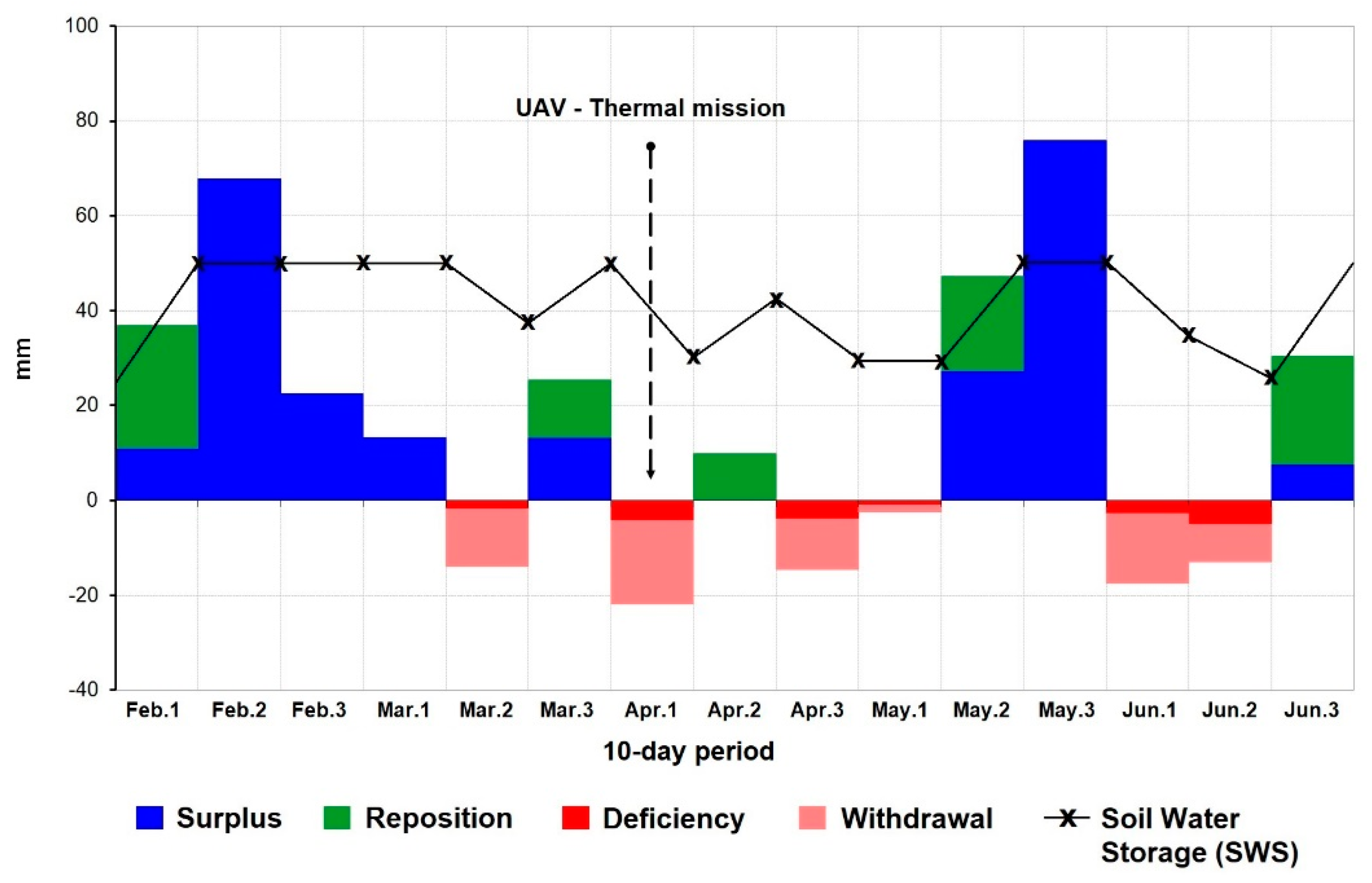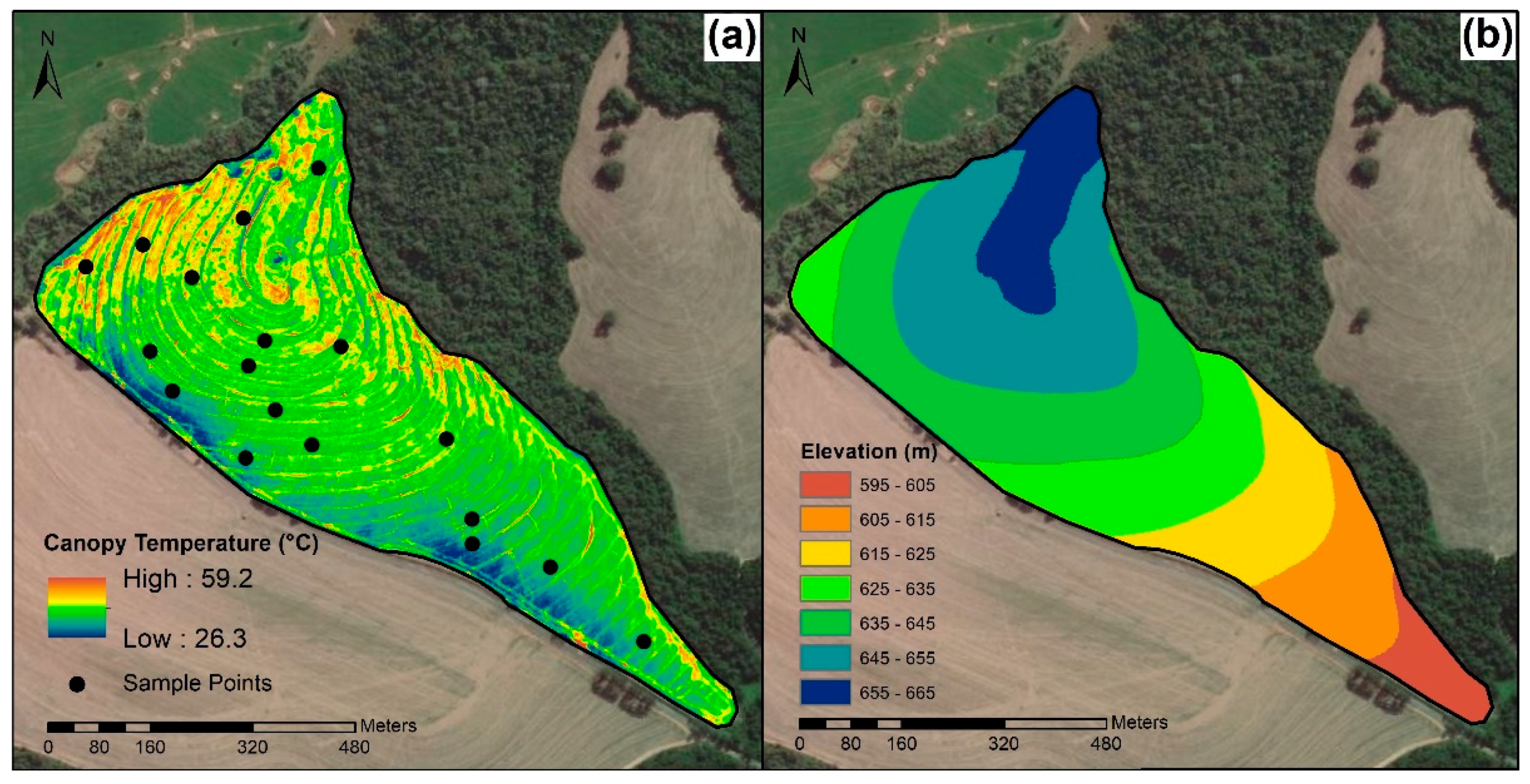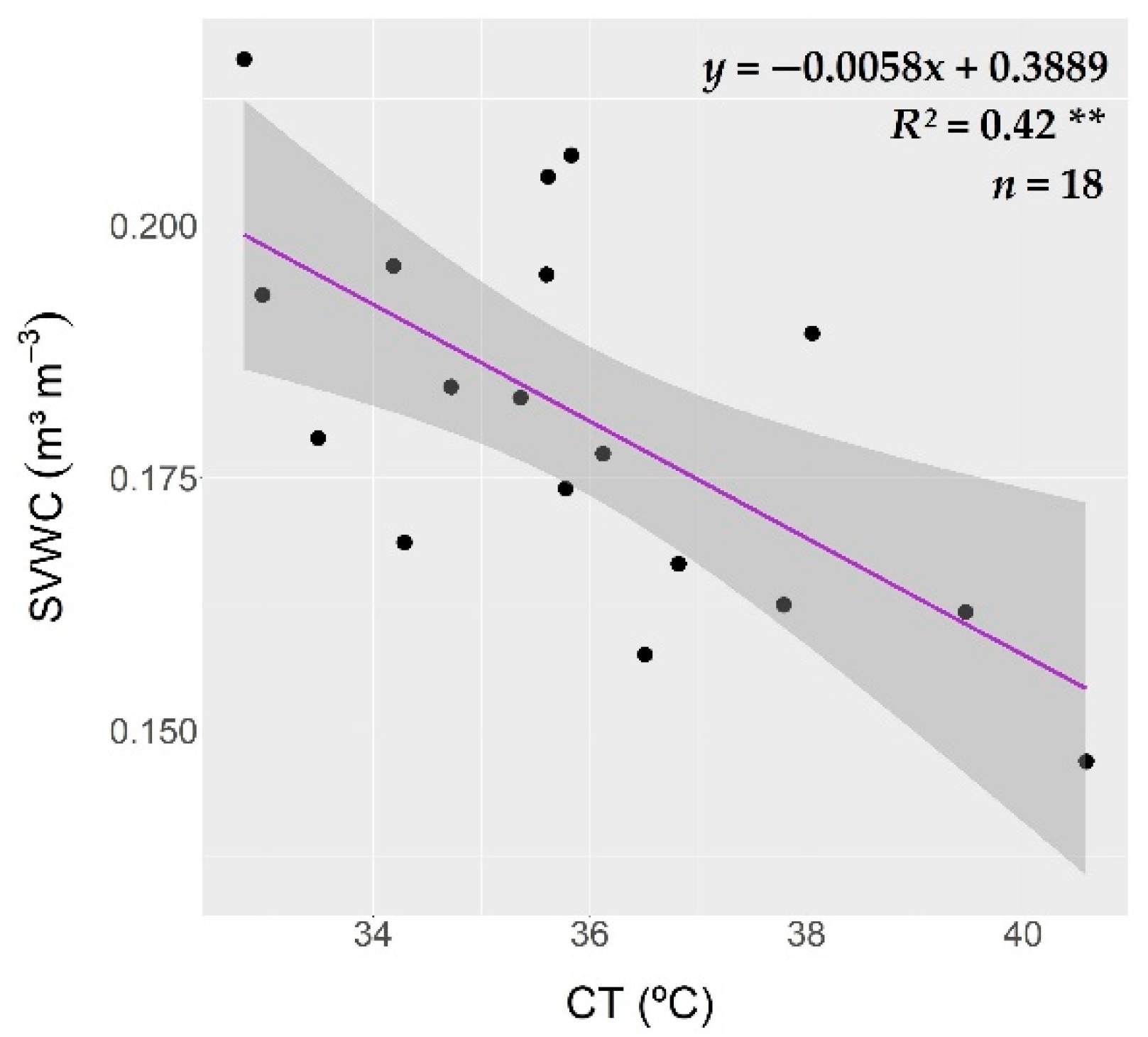Predicting Soil Water Content on Rainfed Maize through Aerial Thermal Imaging
Abstract
:1. Introduction
2. Materials and Methods
2.1. Study Area
2.2. UAV Thermal Imagery
2.3. Field Data
2.3.1. Soil Attributes
2.3.2. Plant Attributes
2.4. Statistical Analysis
3. Results
4. Discussion
5. Conclusions
Author Contributions
Funding
Acknowledgments
Conflicts of Interest
References
- Lambers, H.; Chapin, F.S.; Pons, T.L. Plant Physiological Ecology; Springer: New York, NY, USA, 2008; ISBN 978-0-387-78340-6. [Google Scholar]
- Gautam, D.; Pagay, V. A Review of Current and Potential Applications of Remote Sensing to Study the Water Status of Horticultural Crops. Agronomy 2020, 10, 140. [Google Scholar] [CrossRef] [Green Version]
- Fedoroff, N.V.; Battisti, D.S.; Beachy, R.N.; Cooper, P.J.; Fischhoff, D.A.; Hodges, C.N.; Knauf, V.C.; Lobell, D.; Mazur, B.J.; Molden, D.; et al. Radically rethinking agriculture for the 21st century. Science 2010, 327, 833–834. [Google Scholar] [CrossRef] [Green Version]
- Gebbers, R.; Adamchuk, V.I. Precision agriculture and food security. Science 2010, 327, 828–831. [Google Scholar] [CrossRef] [PubMed]
- Mulla, D.J. Twenty five years of remote sensing in precision agriculture: Key advances and remaining knowledge gaps. Biosyst. Eng. 2013, 114, 358–371. [Google Scholar] [CrossRef]
- Maes, W.H.; Steppe, K. Perspectives for remote sensing with unmanned aerial vehicles in precision agriculture. Trends Plant Sci. 2019, 24, 152–164. [Google Scholar] [CrossRef]
- Mulla, D.J.; McBratney, A.B. Soil spatial variability. In Handbook of Soil Science; Sumner, M.E., Ed.; CRS Press: Boca Raton, FL, USA, 2000; pp. 321–352. [Google Scholar]
- Heiskanen, J.; Mäkitalo, K. Soil water-retention characteristics of Scots pine and Norway spruce forest sites in Finnish Lapland. For. Ecol. Manag. 2002, 162, 137–152. [Google Scholar] [CrossRef]
- Sobieraj, J.A.; Elsenbeer, H.; Cameron, G. Scale dependency in spatial patterns of saturated hydraulic conductivity. Catena 2004, 55, 49–77. [Google Scholar] [CrossRef]
- Iqbal, J.; Thomasson, J.A.; Jenkins, J.N.; Owens, P.R.; Whisler, F.D. Spatial variability analysis of soil physical properties of alluvial soils. Soil Sci. Soc. Am. J. 2005, 69, 1338. [Google Scholar] [CrossRef]
- Idso, S.B.; Jackson, R.D.; Pinter, P.J., Jr.; Reginato, R.J.; Hatfield, J.L. Normalizing the stress-degree-day parameter for environmental variability. Agric. Meteorol. 1981, 24, 45–55. [Google Scholar] [CrossRef]
- Jones, H.G. Irrigation scheduling: Advantages and pitfalls of plant-based methods. J. Exp. Bot. 2004, 55, 2427–2436. [Google Scholar] [CrossRef] [PubMed] [Green Version]
- Gago, J.; Douthe, C.; Coopman, R.; Gallego, P.; Ribas-Carbo, M.; Flexas, J.; Escalona, J.; Medrano, H. UAVs challenge to assess water stress for sustainable agriculture. Agric. Water Manag. 2015, 153, 9–19. [Google Scholar] [CrossRef]
- Jackson, R.D.; Idso, S.B.; Reginato, R.J.; Pinter, P.J., Jr. Canopy temperature as a crop water stress indicator. Water Resour. Res. 1981, 17, 1133–1138. [Google Scholar] [CrossRef]
- Zhang, L.; Niu, Y.; Zhang, H.; Han, W.; Li, G.; Tang, J.; Peng, X. Maize canopy temperature extracted from UAV thermal and RGB imagery and its application in water stress monitoring. Front. Plant Sci. 2019, 10, 1270. [Google Scholar] [CrossRef] [PubMed]
- Crusiol, L.G.T.; Nanni, M.R.; Furlanetto, R.H.; Sibaldelli, R.N.R.; Cezar, E.; Mertz-Henning, L.M.; Nepomuceno, A.L.; Neumaier, N.; Farias, J.R.B. UAV-based thermal imaging in the assessment of water status of soybean plants. Int. J. Remote Sens. 2020, 41, 3243–3265. [Google Scholar] [CrossRef]
- Bian, J.; Zhang, Z.; Chen, J.; Chen, H.; Cui, C.; Li, X.; Chen, S.; Fu, Q. Simplified Evaluation of Cotton Water Stress Using High Resolution Unmanned Aerial Vehicle Thermal Imagery. Remote Sens. 2019, 11, 267. [Google Scholar] [CrossRef] [Green Version]
- Zhou, J.; Khot, L.R.; Boydston, R.A.; Miklas, P.N.; Porter, L. Low altitude remote sensing technologies for crop stress monitoring: A case study on spatial and temporal monitoring of irrigated pinto bean. Precis. Agric. 2018, 19, 555–569. [Google Scholar] [CrossRef]
- Zarco-Tejada, P.J.; González-Dugo, V.; Berni, J.A.J. Fluorescence, temperature and narrow-band indices acquired from a UAV platform for water stress detection using a micro-hyperspectral imager and a thermal camera. Remote Sens. Environ. 2012, 117, 322–337. [Google Scholar] [CrossRef]
- Bellvert, J.; Zarco-Tejada, P.J.; Girona, J.; Fereres, E. Mapping crop water stress index in a ‘Pinot-noir’ vineyard: Comparing ground measurements with thermal remote sensing imagery from an unmanned aerial vehicle. Precis. Agric. 2014, 15, 361–376. [Google Scholar] [CrossRef]
- Matese, A.; Baraldi, R.; Berton, A.; Cesaraccio, C.; Di Gennaro, S.F.; Duce, P.; Facini, O.; Mameli, M.G.; Piga, A.; Zaldei, A. Estimation of Water Stress in Grapevines Using Proximal and Remote Sensing Methods. Remote Sens. 2018, 10, 114. [Google Scholar] [CrossRef] [Green Version]
- Berni, J.; Zarco-Tejada, P.; Suarez, L.; Fereres, E. Thermal and narrowband multispectral remote sensing for vegetation monitoring from an unmanned aerial vehicle. IEEE Trans. Geosci. Remote Sens. 2009, 47, 722–738. [Google Scholar] [CrossRef] [Green Version]
- Klemas, V.V. Coastal and Environmental Remote Sensing from Unmanned Aerial Vehicles: An Overview. J. Coast. Res. 2015, 31, 1260–1267. [Google Scholar] [CrossRef] [Green Version]
- Aubrecht, D.M.; Helliker, B.R.; Goulden, M.L.; Roberts, D.A.; Still, C.J.; Richardson, A.D. Continuous, long-term, high-frequency thermal imaging of vegetation: Uncertainties and recommended best practices. Agric. For. Meteorol. 2016, 228, 315–326. [Google Scholar] [CrossRef] [Green Version]
- Kelly, J.; Kljun, N.; Olsson, P.-O.; Mihai, L.; Liljeblad, B.; Weslien, P.; Klemedtsson, L.; Eklundh, L. Challenges and Best Practices for Deriving Temperature Data from an Uncalibrated UAV Thermal Infrared Camera. Remote Sens. 2019, 11, 567. [Google Scholar] [CrossRef] [Green Version]
- Radoglou-Grammatikis, P.; Sarigiannidis, P.; Lagkas, T.; Moscholios, I. A compilation of UAV applications for precision agriculture. Comput. Netw. 2020, 172, 107148. [Google Scholar] [CrossRef]
- Alvares, C.A.; Stape, J.L.; Sentelhas, P.C.; de Moraes Gonçalves, J.L.; Sparovek, G. Köppen’s climate classification map for Brazil. Meteorol. Z. 2013, 22, 711–728. [Google Scholar] [CrossRef]
- Tremocoldi, W.A.; Brunini, O. Caracterização agroclimática das unidades da Secretaria de Agricultura e Abastecimento do Estado de São Paulo: Capão Bonito e região. Bol. Téc. Inst. Agron. Camp. 2008, 205, 30. [Google Scholar]
- Rossi, M. Mapa Pedológico do Estado de São Paulo: Revisado e Ampliado; Instituto Florestal (Florestal Institute): São Paulo, Brazil, 2017; Volume 1, ISBN 3239660180. [Google Scholar]
- Thornthwaite, C.W.; Mather, J.R. The Water Balance; Laboratory in Climatology, Johns Hopkins University: Baltimore, MD, USA, 1955; Volume 8, pp. 1–104. [Google Scholar]
- Alchanatis, V.; Cohen, Y.; Cohen, S.; Moller, M.; Sprinstin, M.; Meron, M.; Tspiris, J.; Saranga, Y.; Sela, E. Evaluation of different approaches for estimating and mapping crop water status in cotton with thermal imaging. Precis. Agric. 2010, 11, 27–41. [Google Scholar] [CrossRef]
- Lu, Z.; Percy, R.G.; Qualset, C.O.; Zeiger, E. Stomatal conductance predicts yields in irrigated Pima cotton and bread wheat grown at high temperatures. J. Exp. Bot. 1998, 49, 453–460. [Google Scholar] [CrossRef] [Green Version]
- Anderson, D.B. Relative humidity or vapor pressure deficit. Ecology 1936, 17, 277–282. [Google Scholar] [CrossRef]
- Acorsi, M.G.; Gimenez, L.M.; Martello, M. Assessing the Performance of a Low-Cost Thermal Camera in Proximal and Aerial Conditions. Remote Sens. 2020, 12, 3591. [Google Scholar] [CrossRef]
- Teixeira, P.C.; Donagemma, G.K.; Fontana, A.; Teixeira, W.G. Manual de Métodos de Análise de Solos, 3rd ed.; Revisada e Ampliada; Embrapa: Brasília, Brazil, 2017; ISBN 978-85-7035-771-7. [Google Scholar]
- Dirksen, C. Soil Physics Measurements; Catena: Reiskirchen, Germany, 1999; ISBN 3923381433. [Google Scholar]
- Van Genuchten, M.T. A closed-form equation for predicting the hydraulic conductivity of unsaturated soils. Soil. Sci. Soc. Am. J. 1980, 44, 892–898. [Google Scholar] [CrossRef] [Green Version]
- Tomasella, J.; Hodnett, M.G.; Rossato, L. Pedotransfer Functions for the Estimation of Soil Water Retention in Brazilian Soils. Soil Sci. Soc. Am. J. 2000, 64, 327–338. [Google Scholar] [CrossRef]
- Zuber, V.; Strimmer, K. High-dimensional regression and variable selection by using CAR scores. Stat. Appl. Genet. Mol. Biol. 2011, 10, 1. [Google Scholar] [CrossRef] [Green Version]
- Mesas-Carrascosa, F.J.; Pérez-Porras, F.; de Larriva, J.E.M.; Frau, C.M.; Agüera-Vega, F.; Carvajal-Ramírez, F.; Martínez-Carricondo, P.; García-Ferrer, A. Drift correction of lightweight microbolometer thermal sensors on-board unmanned aerial vehicles. Remote Sens. 2018, 10, 615. [Google Scholar] [CrossRef] [Green Version]
- Khanal, S.; Fulton, J.; Shearer, S. An overview of current and potential applications of thermal remote sensing in precision agriculture. Comput. Electron. Agric. 2017, 139, 22–32. [Google Scholar] [CrossRef]
- O’Toole, J.C.; Real, J.G. Estimation of aerodynamic and crop resistances from canopy temperature. Agron. J. 1986, 78, 305–310. [Google Scholar] [CrossRef]
- Gholipoor, M.; Choudhary, S.; Sinclair, T.R.; Messina, C.D.; Cooper, M. Transpiration response of maize hybrids to atmospheric vapor pressure deficit. J. Agron. Crop Sci. 2013, 199, 155–160. [Google Scholar] [CrossRef]
- Yang, Z.; Sinclair, T.R.; Zhu, M.; Messina, C.D.; Cooper, M.; Hammer, G.L. Temperature effect on transpiration response of maize plants to vapour pressure deficit. Environ. Exp. Bot. 2012, 78, 157–162. [Google Scholar] [CrossRef]
- DeJonge, K.C.; Taghvaeian, S.; Trout, T.J.; Comas, L.H. Comparison of canopy temperature-based water stress indices for maize. Agric. Water Manag. 2015, 156, 51–62. [Google Scholar] [CrossRef]
- Bhandari, M. Use of Infrared Thermal Imaging for Estimating Canopy Temperature in Wheat and Maize. Master’s Thesis, West Texas A&M University, Canyon, TX, USA, 13 September 2016. Available online: https://wtamu-ir.tdl.org/handle/11310/133 (accessed on 5 October 2021).
- Zia, S.; Romano, G.; Spreer, W.; Sanchez, C.; Cairns, J.; Araus, J.; Müller, J. Infrared thermal imaging as a rapid tool for identifying water-stress tolerant maize genotypes of different phenology. J. Agron. Crop Sci. 2013, 199, 75–84. [Google Scholar] [CrossRef]




| Variables | Abbrev | Unit | n | Mean | Min | Max | SD | CV (%) | Skew | Kurt |
|---|---|---|---|---|---|---|---|---|---|---|
| Sand | - | % | 18 | 54.34 | 45.10 | 59.70 | 4.48 | 8.05 | −1.10 | 0.17 |
| Clay | - | % | 18 | 29.42 | 22.30 | 37.30 | 4.46 | 15.04 | 0.55 | −0.37 |
| Silt | - | % | 18 | 16.24 | 7.80 | 29.60 | 5.87 | 38.10 | 0.58 | 0.09 |
| Organic Matter | OM | % | 18 | 2.72 | 1.90 | 4.20 | 0.49 | 18.29 | 1.47 | 4.23 |
| Microporosity | MiP | m3 m−3 | 18 | 0.32 | 0.28 | 0.35 | 0.02 | 6.79 | 0.22 | −0.63 |
| Macroporosity | MaP | m3 m−3 | 18 | 0.06 | 0.04 | 0.08 | 0.01 | 23.25 | 0.18 | −0.62 |
| Bulk Density | BD | Mg m−3 | 18 | 1.44 | 1.26 | 1.59 | 0.08 | 5.50 | −0.38 | 0.79 |
| Soil Resistance to Penetration (0–0.1 m) | SRP0–0.1m | KPa | 18 | 1000.98 | 572.25 | 1698.45 | 289.96 | 28.70 | 0.57 | 0.39 |
| Soil Resistance to Penetration (0.1–0.2 m) | SRP0.1–0.2m | KPa | 18 | 2167.81 | 1681.40 | 2602.90 | 258.08 | 12.17 | 0.01 | −0.97 |
| Soil Resistance to Penetration (0.2–0.3 m) | SRP0.2–0.3m | KPa | 18 | 1928.53 | 1583.15 | 2449.40 | 229.27 | 12.29 | 0.60 | −0.12 |
| Soil Volumetric Water Content | SVWC | m3 m−3 | 18 | 0.18 | 0.15 | 0.22 | 0.02 | 10.39 | 0.08 | −0.63 |
| Soil Water Holding Capacity | SWHC | mm | 18 | 51.61 | 41.10 | 72.41 | 7.92 | 15.96 | 1.13 | 1.39 |
| Fresh Biomass | FBM | Mg ha−1 | 18 | 30.43 | 17.80 | 36.54 | 5.41 | 17.60 | −1.27 | 1.41 |
| Grain Yield | YLD | Mg ha−1 | 18 | 9.14 | 6.98 | 11.45 | 1.26 | 13.70 | −0.18 | −0.69 |
| Canopy Temperature | CT | °C | 18 | 35.89 | 32.81 | 40.58 | 2.11 | 5.90 | 0.63 | 0.21 |
| Sand | Clay | Silt | OM | MiP | MaP | BD | SRP0–0.1m | SRP0.1–0.2m | SRP0.2–0.3m | SVWC | SWHC | FBM | YLD | CT | |
|---|---|---|---|---|---|---|---|---|---|---|---|---|---|---|---|
| Sand | 1 | −0.14 | −0.65 ** | 0.31 | −0.75 *** | 0.40 | 0.11 | −0.13 | 0.04 | −0.29 | −0.01 | −0.16 | 0.28 | 0.18 | −0.05 |
| Clay | 1 | −0.65 ** | 0.09 | 0.51 * | 0.55 * | −0.79 *** | −0.29 | −0.28 | −0.50 * | 0.61 ** | 0.86 *** | 0.13 | −0.32 | −0.44 | |
| Silt | 1 | −0.31 | 0.19 | −0.72 *** | 0.52 * | 0.32 | 0.18 | 0.60 ** | −0.46 | −0.53 * | −0.31 | 0.11 | 0.37 | ||
| OM | 1 | −0.29 | 0.37 | −0.13 | −0.37 | −0.09 | −0.16 | 0.13 | 0.17 | 0.36 | 0.03 | −0.13 | |||
| MiP | 1 | −0.09 | −0.48 * | 0.34 | 0.17 | 0.00 | 0.10 | 0.54 * | −0.41 | −0.45 | 0.05 | ||||
| MaP | 1 | −0.79 *** | −0.31 | −0.31 | −0.68 ** | 0.37 | 0.63 ** | 0.22 | 0.06 | −0.45 | |||||
| BD | 1 | 0.15 | 0.28 | 0.60 ** | −0.34 | −0.88 *** | 0.01 | 0.24 | 0.34 | ||||||
| SRP0–0.1m | 1 | 0.83 *** | 0.22 | −0.40 | −0.26 | −0.47 * | −0.15 | 0.58 * | |||||||
| SRP0.1–0.2m | 1 | 0.30 | −0.27 | −0.31 | −0.20 | 0.09 | 0.47 | ||||||||
| SRP0.2–0.3m | 1 | −0.55 * | −0.50 * | −0.25 | 0.30 | 0.21 | |||||||||
| SVWC | 1 | 0.42 | 0.64 ** | 0.15 | −0.65 ** | ||||||||||
| SWHC | 1 | 0.10 | −0.31 | −0.45 | |||||||||||
| FBM | 1 | 0.51 * | −0.56 * | ||||||||||||
| YLD | 1 | −0.45 | |||||||||||||
| CT | 1 | ||||||||||||||
| Estimate | Std. Error | t Value | Pr(>|t|) | CAR | |
|---|---|---|---|---|---|
| (Intercept) | −14.2500 | 10.8539 | −1.313 | 0.237 | - |
| Sand | 0.0145 | 0.0110 | 1.319 | 0.235 | 0.003 |
| Clay | 0.0154 | 0.0113 | 1.361 | 0.222 | 0.289 |
| Silt | 0.0148 | 0.0111 | 1.336 | 0.230 | 0.008 |
| OM | 6.3 × 10−4 | 7.79 × 10−4 | 0.814 | 0.447 | 0.004 |
| MiP | −0.9592 | 0.7168 | −1.338 | 0.229 | 0.000 |
| MaP | −0.2889 | 0.8593 | −0.336 | 0.748 | 0.004 |
| BD | 0.1102 | 0.1569 | 0.703 | 0.509 | 0.008 |
| SRP0–0.1m | 3.77 × 10−5 | 3.79 × 10−5 | 0.994 | 0.359 | 0.037 |
| SRP0.1–0.2m | 1.29 × 10−6 | 2.75 × 10−5 | 0.047 | 0.964 | 0.000 |
| SRP0.2–0.3m | −5.82 × 10−5 | 1.76 × 10−5 | −3.316 | 0.016 | 0.240 |
| CT | −0.0039 | 0.0021 | −1.899 | 0.106 | 0.286 |
| R2 multiple | 0.88 | ||||
| F test (p-value) | 0.05 | ||||
| Shapiro–Wilk (p-value) | 0.77 | ||||
Publisher’s Note: MDPI stays neutral with regard to jurisdictional claims in published maps and institutional affiliations. |
© 2021 by the authors. Licensee MDPI, Basel, Switzerland. This article is an open access article distributed under the terms and conditions of the Creative Commons Attribution (CC BY) license (https://creativecommons.org/licenses/by/4.0/).
Share and Cite
Acorsi, M.G.; Gimenez, L.M. Predicting Soil Water Content on Rainfed Maize through Aerial Thermal Imaging. AgriEngineering 2021, 3, 942-953. https://doi.org/10.3390/agriengineering3040059
Acorsi MG, Gimenez LM. Predicting Soil Water Content on Rainfed Maize through Aerial Thermal Imaging. AgriEngineering. 2021; 3(4):942-953. https://doi.org/10.3390/agriengineering3040059
Chicago/Turabian StyleAcorsi, Matheus Gabriel, and Leandro Maria Gimenez. 2021. "Predicting Soil Water Content on Rainfed Maize through Aerial Thermal Imaging" AgriEngineering 3, no. 4: 942-953. https://doi.org/10.3390/agriengineering3040059
APA StyleAcorsi, M. G., & Gimenez, L. M. (2021). Predicting Soil Water Content on Rainfed Maize through Aerial Thermal Imaging. AgriEngineering, 3(4), 942-953. https://doi.org/10.3390/agriengineering3040059






